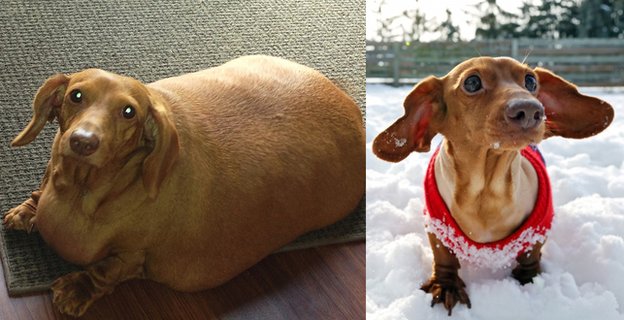We know Dennis the Daschund is a bit of an extreme example – but consider this: the rate of obesity in Australians is increasing at an alarming rate, in both adults and children. According to Australian Government statistics, 20% -25% of children are now overweight or obese and if this trend continues by 2020 – in just 3 year’s time – 80% of all adults and a third of all children will fall into that category.
The scary thing for pet owners is that obesity is not confined to humans. Our pets are now showing similar trends. And make no mistake it’s entirely OUR FAULT!
We establish our pet’s lifestyle. If they’re eating the wrong food it’s because we give it to them. If they are confined to small areas, it’s because we live there. If they don’t get exercise it’s because we’re not providing it.
Humans have a choice. Dogs and cats don’t.
Your pet relies on you to be responsible and make sure they’re leading a healthy life. An overweight dog or cat is at risk from all the same diseases that affect obese humans – diabetes, high cholesterol, liver and digestive problems, breathing difficulty, increased risk of cancer, lack of energy and lots more. All this means that an overweight pet is likely to have a shorter life than otherwise – and whilst we know that we will most likely outlive our pets, we still want them to be around as long as possible.
But our lifestyle, particularly in the cities, tends to make us lazy when it comes to taking care of our animals. Dogs in particular need more exercise than cats and many people are just too busy with their own lives to take the time, even though they themselves would benefit from exercising their dog. The other mistake that people make is assuming that their dog is exercising when left alone during the day in an outdoor area. For the most part this simply doesn’t happen!
Why pets become overweight
You could be unwittingly contributing to poor health for your pet by:
- Over feeding, without considering their energy output.
- Giving treats, leftovers, bits and pieces that all add up to too many calories.
- Lack of exercise. Don’t encourage your pet be a couch potato.
- Not finding out the different needs for different breeds and sizes and their typical habits, some dogs are natural ‘greedy gutses’, (think Labradors and Beagles), so extra vigilance is required.
What to do about it
First, consult your vet to make sure your pet doesn’t have any health problems of which you are unaware. Get some advice from the vet as to the target weight you should aim for. Explain to your family that they must all follow the rules
- Cut out snacks, offcuts and table scraps.
- Do not overfeed. Set a kilojoule limit. Discuss this with your vet.
- Try splitting the daily amount of food into two or three meals to help alleviate hunger and burn kilojoules throughout the day.
- Try to give your pet more fresh food, not just processed dry food.
- Use exercise to burn kilojoules and improve fitness – just the same as for humans. Start with a gentle walk and increase the time and distance gradually. This applies more to dogs than to cats of course. Try to let your dog off the lead and encourage running by playing games such as fetching a stick.
It’s just like your kids. You’re not being kind to your pet if you use food to show your love. In fact, you run the risk of loving them to death!







Leave A Comment